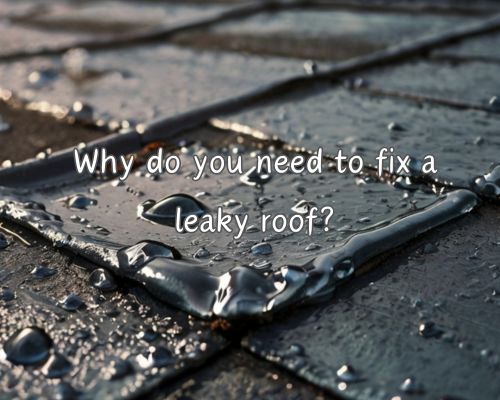
Why Do You Need to Fix a Leaky Roof?
Essential Reasons to Act Now
A leaky roof is more than just an inconvenience; it’s a gateway to significant damage in your home.
David Spade from Star Roofing Contractors has to say “Ignoring a leaky roof can lead to mold growth, structural issues, and increased repair costs over time. Water seeping in through a compromised roof not only damages ceilings and walls but can also ruin insulation and electrical systems, posing potential safety hazards.”

Addressing a roof leak promptly helps maintain the integrity of your home.
When water finds its way through a damaged roof, it can weaken the entire structure, making your home vulnerable to further damage from the elements.
You may also find that persistent leaks can negatively affect the energy efficiency of your home, leading to higher utility bills.
Beyond the physical damage, a leaking roof can reduce the overall value of your property.
Prospective buyers are less likely to invest in a home with visible signs of neglect and potential water damage.
By fixing your roof leaks quickly, you protect not only your living environment but also your investment, ensuring your home remains safe, comfortable, and desirable.
Identifying Causes of Leaky Roofs
Understanding the reasons behind a leaky roof is essential for timely and effective repairs.
Common culprits range from compromised shingles and flashing to issues around roof features and general structural deterioration.
Compromised Shingles and Flashing
Shingles and flashing often bear the brunt of roof damage.
Shingles could become cracked or missing due to heavy winds or debris impact, allowing moisture to penetrate the roof deck.
Flashing—thin metal strips installed around roof features like chimneys and skylights—is another critical area.
When flashing is improperly installed or deteriorates over time, it can lead to leaks.
Moisture that enters through these areas can cause rot and mold growth.
Regularly inspecting and replacing damaged shingles or flashing can prevent such issues from escalating.
Wear and Tear Around Roof Features
Roof features like vents, chimneys, and skylights are common leak sources.
Plumbing vent boots and vent boots can fail, leading to gaps where water can seep in.
Skylights and chimneys may develop cracks or gaps in the seal, often exacerbated by heavy rains or poor initial installation.
These areas require regular maintenance and prompt attention to signs of wear, such as cracks or loose fasteners.
Addressing these issues can prevent further roof deck or framing damage.
Structural Deterioration
Over time, all roofs experience some level of structural deterioration.
Rafters and framing in older roofs may also degrade, making the whole structure more vulnerable to leaks.
Regular inspections can help identify early signs of deterioration.
Catching these issues early allows for targeted repairs, preventing more extensive damage that could compromise the integrity of your entire roof.
Addressing Roof Leaks
To effectively address roof leaks, consider both immediate and long-term solutions. Regular maintenance also plays a crucial role in preventing future issues.
Short-Term Fixes and DIY Repair
Short-term repairs can be done using a few tools and materials you may already have.
First, locate the leak by spraying your roof with a garden hose and using a flashlight to spot water entry points.
Once found, clear any debris near the leaky area.
Apply roofing cement or sealant to seal small cracks or holes. Use a putty knife to spread the cement evenly.
For more extensive damage, you may need to remove shingles.
Start two rows above the damaged shingles, pry out the roofing nails, and replace any damaged sections, making sure to use new nails.
Long-Term Solutions and Professional Repair
For long-term solutions, hiring a professional roofer or roofing contractor is often necessary.
Professionals like David Spade from Star Roofing Contractors, can thoroughly inspect the roof and offer a warranty on roof repair or roof replacement.
They might use high-quality materials like TPO membrane or advanced sealants.
Contractors are also skilled in reapplying or replacing roofing underlayment, ensuring better longevity.
Professional repair not only offers durability but also comes with safety assurances.
Professionals adhere to safety standards and can work around your home without risking accidents.
Preventative Measures and Regular Maintenance
Preventative measures are essential for avoiding leaks altogether.
Ensure your gutters are free of debris. Clogged gutters can cause water overflow and damage.
Check your roof and attic for proper ventilation. Poor ventilation can lead to excess moisture buildup.
A professional roofing contractor can do regular inspections. These inspections can identify potential issues before they become significant problems.
They will check roof flashing, caulking seals, and ensure no shingles are loose or missing.
Keeping an eye on your roof’s condition will help extend its lifespan and prevent costly repairs in the future.